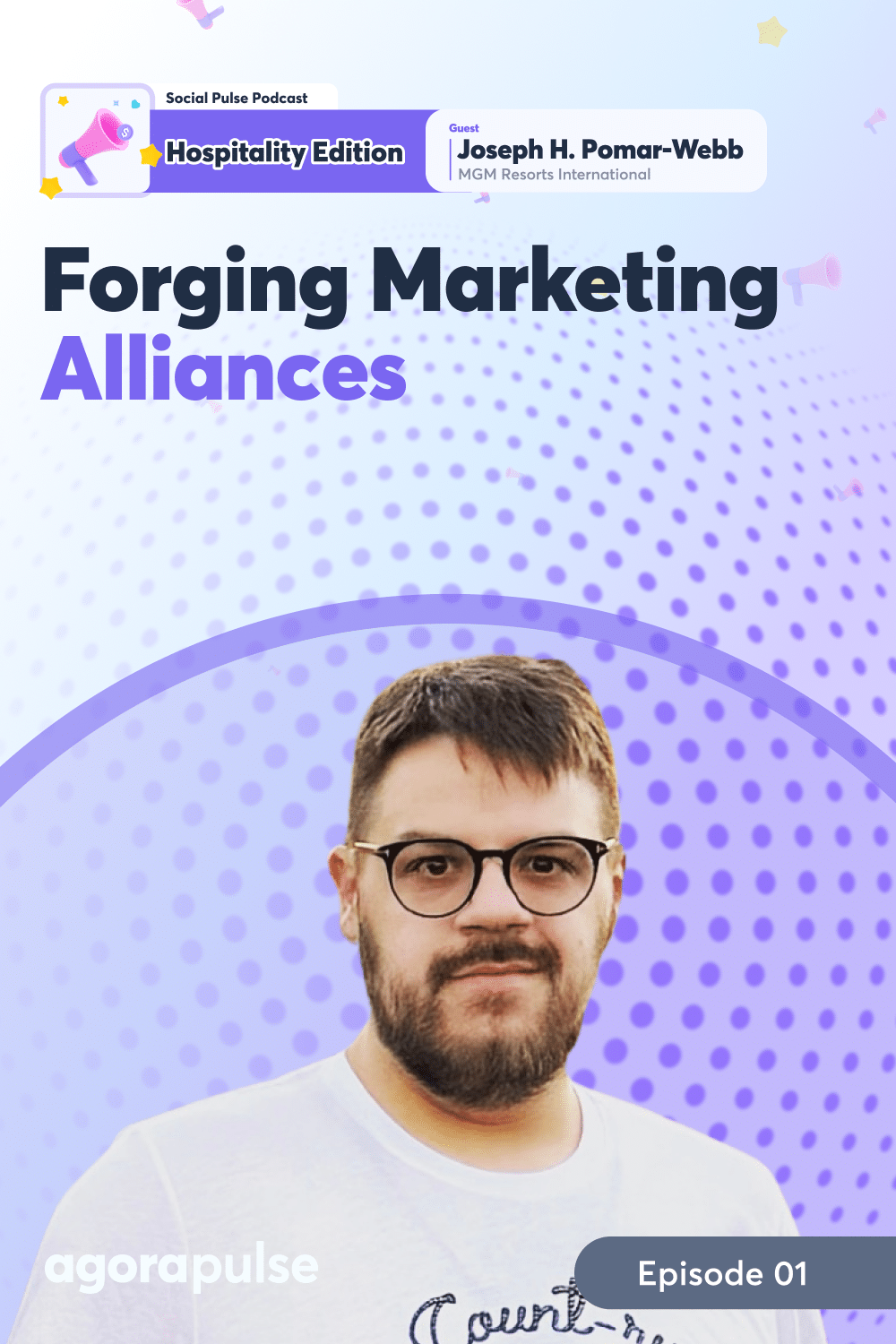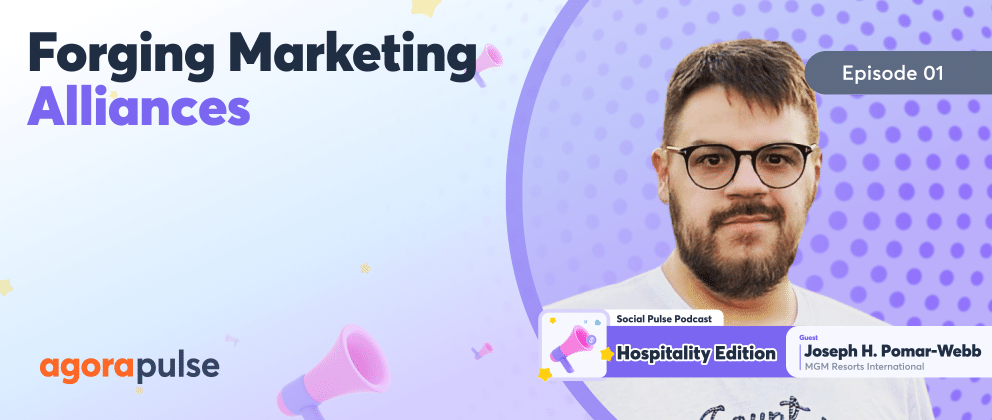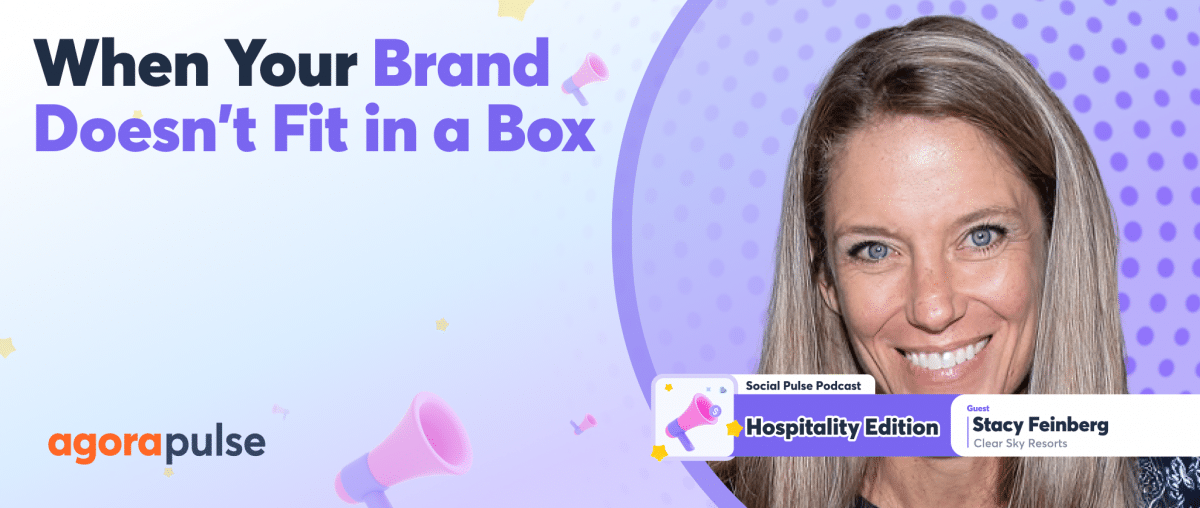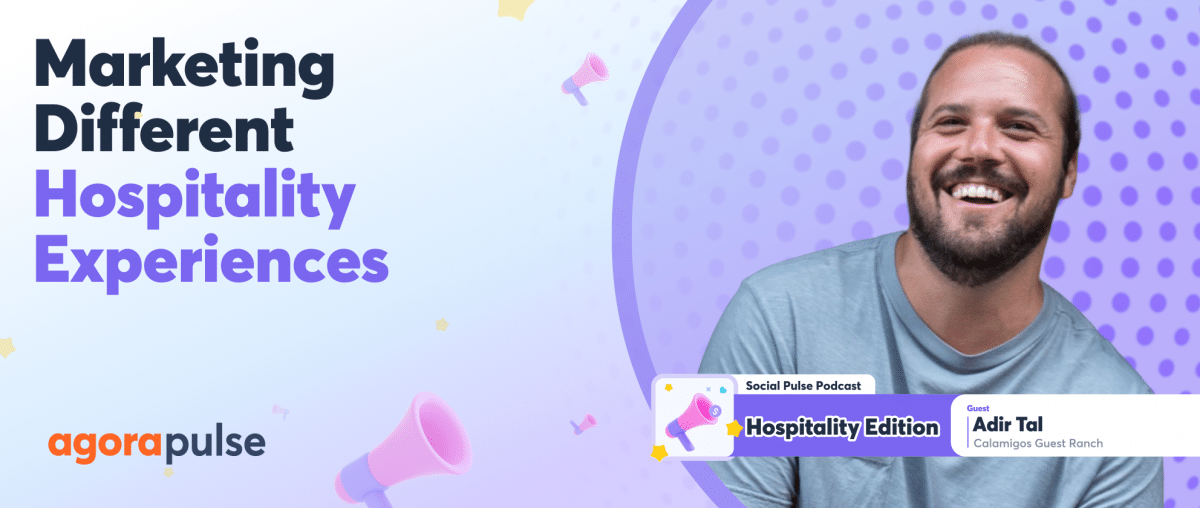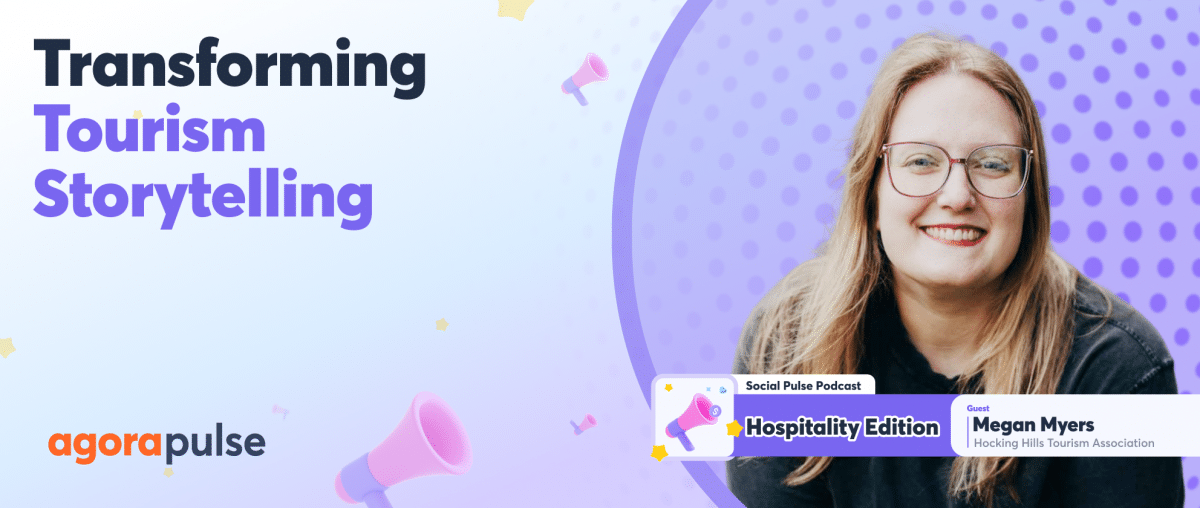My friend Rebekah Radice once said that if you take a sincere interest in others, they’ll take a real interest in you. Build relationships. Don’t collect them. Her point was not only to stress the importance of authentic relationship building in business but also a warning to those who might approach relationships with colleagues or other departments as simply checking a box. Because the truth is, particularly in social media, we cannot be successful if we aren’t building bridges throughout our entire organization. Those relationships not only help you be better at your job, but they also help others see and value the work you’re doing.
So where do we get started?
That’s exactly what Joseph H. Pomar-Webb talked to us in this recap of Social Pulse Podcast: Hospitality Edition, hosted by Agorapulse’s chief storyteller, Mike Allton. Listen to the whole episode below or read the recap.
Joseph is the social marketing manager for MGM Resorts International. He’s represented some of the most iconic brands in the tour and travel hospitality space, such as MGM Grand and Excalibur. Joseph is currently based in Las Vegas, is an eternal tourist and enjoys spending his days at any tourist tap.
Let’s start by talking about the work you’re doing today for MGM.
Can you share what your day-to-day looks like and what you’re responsible for?
Joseph Pomar-Webb: Yeah, so currently in my current role, I am the social marketing manager overseeing the enterprise for MGM Resorts.
What that means is I oversee all the corporate handles. So MGM Resorts International, MGM Rewards, which is our loyalty program, as well as executive presence. We always like to say, “If it touches more than one property under the MGM Resorts umbrella, I’m the one working on the strategy behind that.”
Day-to-day looks like every other social marketing job. It’s content creation, curation, reporting, data. And then our daily meetings.
What’s unique about my role, specifically, is that we oversee so many different brands that are quite literally right next to each other. We never know what we’re going to be doing from Monday morning to Monday afternoon. And I mean, quite literally, we could be sitting in our Monday morning catch-up meeting with the whole team. Cut two later that afternoon: I’m sitting on our private jet, talking to the VP of aviation about what we’re doing from a corporate perspective about CSR and our green footprint.
We never know what we’re going to be doing.
Now, for those who maybe aren’t too familiar with MGM, when you talk about having different properties, what do you mean by that?
Joseph Pomar-Webb: When people hear MGM, they think of Las Vegas, but in particular, they think of the big green building on the corner.
MGM Resorts is so much more than that. We have several resorts all up and down the Las Vegas Strip. Some of the most notable are MGM Grand, Bellagio, Aria, Mandalay Bay, Luxor, Excalibur, New York, New York, Park MGM, as well as different locations across the country, as well in Asia.
Mike Allton: And each one of those locations has their own social media footprint and set of profiles, don’t they?
Joseph Pomar-Webb: Each profile/account has its own set of profiles. And then each regional has their own sets, and they live in their ecosystem as well.
Mike Allton: There’s a lot that’s going on now in an organization the size of MGM. I imagine social media could be an afterthought sometimes.
Has [social media] been a challenge for you and how have you worked to overcome it?
Joseph Pomar-Webb: I’ve been with the company now for about five years, and I will say, from day one to day now, social has changed in its positioning in the company, so we used to be an afterthought, but now for the most part, we are a forethought, so it’s “What does social think of this? How can we produce for social media?”
I’m not saying it doesn’t happen. It still absolutely happens. Such is the plight of every social manager ever.
But how we overcome that is by making sure that we are showing up at the table, keep kicking down doors every time we encounter one, and we also keep showing that we and our team can provide real value to your client’s business objectives. So if you can walk in and show why you’re important at the table, your seat at the table will always be available for you.
Mike Allton: That makes a lot of sense. That’s something we talk about a lot at Agorapulse. Sometimes it’s more framed from a revenue and ROI perspective.
We talk about going from being a cost center to a profit center, but it’s the same concept, right? Where you’re showing your value and having those conversations.
When building relationships internally and knocking down those doors, how would you recommend other social media managers approach that? Where should they start?
Joseph Pomar-Webb: Believe it or not, building relationships starts with one simple step, and it’s the most important step: showing up.
- Just show up.
- Meet with the people who are on your brands. If you think of yourself as a service provider, you’re an agency of one (or, in my case, you’re a center of you) part of a center of excellence, show up to your brand partners. They know the brand better than you do. They live in it every single day. They have institutional knowledge that we’re desperately craving as social media managers.
- Show up.
- Give them face time.
- Talk about what you plan to do for them/how you plan to do it with them.
- Most importantly, get to know them. And I don’t mean on a surface level, like, “Oh, this is so-and-so, a director of marketing at this place.”
- No, actually get to know them, figure out a few of their likes and dislikes, if they have kids or not.
Take an interest in them.
I guarantee that if you can create cohesion with your team, you can create band cohesion between what traditional marketing platforms are doing and what social is doing.
Mike Allton: That is a huge point because what you’re doing by learning about people, you know, below that surface level, you’re developing rapport, right? You’re learning what they like and what they don’t like.
Examples of Brand Partners
I’m just curious now in an organization like MGM, when you talk about brand partners, I’m imagining you mean like other departments in the company. What are some examples of those?
Joseph Pomar-Webb: So when I say, particularly speaking to MGM, when I say your brand partners—MGM is divided in how we take our marketing approach.
Social media currently sits at the corporate level in a Center of Excellence. So that means there’s no social manager physically sitting in New York, New York, or physically sitting at Vdara. We have an entire centralized social team that oversees all these handles.
So when I say your property partners or your brand partners, I mean actually walking into property and going to MGM Grants marketing team, because you are an extension of their team and getting to know them, getting to know rapport and the better you get to know them. The faster both teams can move, the more agile you become because then you go, well, I know Mike doesn’t like X, Y, and Z because X, Y, and Z. So I know how to activate on my channels now per my clients parameters.
Mike Allton: I appreciate that example because some of you [reading] might be trying to think about how what Joseph is saying will apply to your organization.
So hopefully some of that resonates with you. Maybe you’ve got multiple properties or maybe you’ve got different marketing teams for each property. Maybe you don’t, but the key here is to think about how your organization is structured, who are the key individuals that you need to work with regularly, and figure out ways to meet them where they’re at (whether that’s physically or virtually, you’ll have to figure that out on your own).
What shouldn’t social media managers in a role like yours do when it comes to relationship building?
Joseph Pomar-Webb: I’m going to say this in a way that I think isn’t as inflammatory as I’m coming across—don’t take prisoners.
I think it’s really easy as a social professional to kind of be playing defense in every room you walk into, right? Those memes where everyone says they can do our job because they have a Facebook page.
Don’t take prisoners. People have real value and real insight. And I’ve probably been with the company longer than you—or maybe not as long as you—but everyone has a unique point of view. So don’t walk into a room and say, “Well, I am the social media expert. Therefore your opinions and thoughts and point of view are null.”
Everyone has something to offer. So always keep an open mind and learn how to strategically say no.
But most importantly—and probably more importantly than strategically saying no—would be how to find, “Well, we can’t do A, but we can possibly do B so that we can find solutions.” So don’t take prisoners.
That’s the best way to kill a relationship before it starts.
How Having a Relationship With Others Helps
Mike Allton: Joseph, I know the tips and the advice that you’re sharing—they’re not just things you read in a book. You’ve experienced the good and the bad.
Can you share an example of a specific time when having that existing relationship with a colleague or another department benefited you and the company?
Joseph Pomar-Webb: I’ll talk about two different times.
One when there was an existing relationship that benefited us, and one when there was a relationship that we had fumbled the ball on, right?
So, an existing one was when I was the social manager over at Excalibur. Luckily, I had built really good rapport with that team. We had become thick as thieves. I knew their personal lives. I knew one was getting married. I knew, even though the three of us no longer work together. I still know what’s going on with them. That’s how close we actually became. And with that, one day, this off the cuff, my client walked into the office that I had posted up in and said, “Hey, just so you know, I have 15 grand that I need to burn that I set aside for you. We just have extra cash and I’m giving it to you” and walked out of the room. And lo and behold, that was the start of building some of the dopest content that I’ve ever was able to create. It aligned perfectly with the brand. We got completely ridiculous. There was quite literally fire involved. It was amazing.
You never know what a relationship will do for you.
You know, it might be monetarily like, “Hi, we can fund your pet project.” Or even then it may be like, “Hey, our company is in crisis. And I know I can trust you to hold this information close to you so that way you can do your job.”
And those things are very important on the opposite side. There’s times where we completely box your relationship. So my team used to kind of joke and say that I was the great fixer. So if you know, our team fumbled a ball somewhere: “Joseph, you’re going to move to this brand to go talk to these people.” And it was my job to kind of fix everything.
One instance in particular was when I was at Harris Cherokee and we had a venue called the Noodle Bar, and it was a really profitable venue. Our players loved it. Our non-hotel, our non-player hotel guests loved the venue, but we could never get in for marketing purposes, and at one point, we couldn’t, we didn’t have any awareness campaigns playing. So there was no on-property collateral. There was no social. There was no web. We had outdated stock images on our website. The restaurant needed help from a marketing perspective, and they were really apprehensive of our team. Luckily, I had worked with our resort’s executive chef on other projects already.
And I actually approached him instead of the other way around. And I said, “Hi, you know, I noticed we have this venue that is particularly beloved and there’s a very real marketing need for it. Would you be willing to have a conversation with me about what you’re needing?”
He was very apprehensive, and the meeting kept getting kicked and kicked and kicked and kicked. And finally, one day I ran into him in the back hallway, and I said, “Chef, I would really like to talk to you about this. You know, I’ve learned a little bit more about the venue’s history with our department by talking through my colleagues, and I think we can do something about that, and I think we can fix it.”
And immediately, his shoulders immediately dropped, and guess what? That call moved up to that day, and he hopped on the call and said, “Well, I’m scared to let you all in the venue because, you know, [the] previous social team didn’t quite execute the way we needed them to. We never quite got content. We never quite saw the content that was captured. What’s going to be different with you?”
And with that, I saw he was open. He was interested. So then that signaled to me, I’m like, okay. When we approach this client, we have to tell them explicitly what we’re going to do and what we can get for them.
So luckily, I already knew what I wanted to do. I pulled up an outline of an entire shoot proposal and I said, we are aiming to collect at minimum 25 assets.
Here’s where all these placements are going to go. Here are how they’re going to be used. Here’s what we want to do with them. Here’s how we will position your venue within our social landscape. Here’s what our traditional marketing efforts can do and here’s what it will be. And at no additional cost to your operating venue because these are costs that we had already assumed.
It went from a pretty rocky, non-existent relationship to a very open, excited, collaborative effort. It got to the point where, you know, Chef would come and find me and be like, “Hey, we have a new menu item that’s coming up at another venue that my own team didn’t even have purview into yet.”
So then it was me going back to them going, “Hey, just so you know, this other restaurant on property is doing a whole new menu this spring and it’s launching in three weeks. Do you all know about it?” And the answer is no. And I was like, great. Well, I do because I built that relationship, and it made our entire company better.
It made our workflow better. It really brought an elevation to the brand, [which] is particularly too low as food and beverage outlets that they just were kind of lacking because it was just kind of, all right, every day we’ll just do the same collateral rotation. And I really put the stop on using stock images with my client.
I said, “Hey, you all make beautiful product. We’re selling your product. Let’s photograph and talk about your product. We don’t need to be going to Getty and pulling a photo of eggs Benedict when you make damn eggs Benedict in all of Appalachia. Let’s do this now.” And it worked out great.
Mike Allton: That’s awesome. And I love that you’re approaching these brands or these businesses as clients, whether you’re working internally for them or not, and you’re really building your team as a service arm of the organization. But I have to say … My listeners will crucify me if I don’t go back on something else you mentioned, which was actually setting fire to something as part of a social media campaign. What was that about?
Joseph Pomar-Webb: This is the best campaign I ever got. And it’s the best content that never saw the light of day. This content was never published. We filmed it in January of 2020. And so y’all know that happened in March of 2020. So this content never saw the light of day, but with Excalibur, it started with a concept of me and my manager at the time, brainstorming like, “Well, they gave us 15 grand.”
How do we spend it? Right. So we go into this meeting and we’re just going to spew word vomit and we’re going to write it on the board and whatever sticks, we’ll go from there and the phrase that stuck out was strippers and french fries.
We said, great, and we started drilling into that. It turned into quite literal sword fights in the hotel lobby with tournament of kings, to Thunder From Down Under guys literally being showered in french fries in a dining restaurant from to quite literally fire breathing at the Excalibur pool. We did light the pool on fire. It did not make the final cut because it was, you know, moving fire was rough to film. But yeah, we did, we did light a pool on fire. It was wild.
Measuring Social ROI
Mike Allton: I want to shift gears a little bit because there’s this concept that I always talk about with the guests. And I particularly want to pull apart how you’re doing it at MGM. And that is to measure the business impact of social media. You’ve got all these profiles. You’ve got these umbrella brand profiles, these individual property profiles.
How are you measuring how the activity on all of these social channels is impacting the business?
Joseph Pomar-Webb: So that’s actually a really great question.
And this is a question that we answer pretty frequently to our stakeholders. Right? So I oversee organic social, paid social at MGM is done by a separate team, still under the same division of the company, but just on a separate department.
And so with organic social, you know, it’s kind of hard to quantify our actual ROI. And so we fall back on our engagement rate. So organic social, as most of us know, is all upper funnel. It is all about awareness, right? And so we fall back on how we provide business value through engagement rates.
We talk about link clicks and impressions. And then we can go back and homogenize all that data and go back to our client and say, “Hi, we served your business need by driving an engagement rate of 3%, which our benchmark is 1%. It resulted in X number of views. It resulted in X number of engagements, X number of link clicks, driving traffic to the website, which the web team can then book and figure out, you know, how much web traffic converted from organic social.” Granted it’s organic social, so that’s never like a super exciting number, but that is how we do it. So we use real-time data to adjust our social strategy. And there’s been several instances, at least with my tenure at MGM, where we go in with a recommendation, say, we want to do x, y, and z for this initiative.
And in the middle of it, we realize it’s not at all resonating with our audience. And so, you know, we investigate our engagement rate. Why is it low? Is it the time of day? Is it what we’re featuring? You know, is it people aren’t even aware that this venue exists, you know, especially when it’s like a new venue.
And so that is how we walk in and provide value to our company. We provide them real data in real-time, and we’re one of the only legs of marketing (here I speak as a social marketer, not just as MGM) that can adjust real-time, right? It’s very different than hanging a billboard and praying that, you know, the billboard along the highway is going to pull someone in versus, you know, we can see real-time, hey, this post is underperforming or this post is overperforming, we can adjust accordingly.
Be Social by Being on Social
What resources do you turn to to keep up with social media?
Joseph Pomar-Webb: So this question is funny, so I do get asked this every once in a while, and this is going to sound like a cop-out answer, and it is, but it isn’t, because the way I keep up with social is quite literally being on social.
There is no better tool (present company excluded, no better podcast). You’re not going to get any actionable insight into what’s going on on those platforms than being on those platforms.
“There’s a concept called living in your brand. And so actually live in your brand.
If you have a brick and mortar, go to the brick and mortar.
If you’re an exclusively digital company, figure out what other digital companies are doing in your space and follow them on social and learn from them.
There is a thousand different great content ideas and trends that may not necessarily relate to your industry, but you could make that happen.”
That’s the only way I keep up on socials.
Being on social, trends come and go very quickly. We’re talking about a tentpole moment. Let’s say Christmas. We’re talking about Halloween thinking Christmas is going to be one way, but then when we get there, geopolitical events have happened. There is a bad winter storm. Suddenly, social has completely changed.
The best way to keep up with social is to just live on social.
Thanks for reading this episode of Social Pulse Podcast: Hospitality Edition, where we’re digging into the challenges, successes, and stories of social media and community professionals in the industry, just like you. Subscribe to gain valuable insights that you’ll be able to apply to your own work and social presence from each and every episode.
